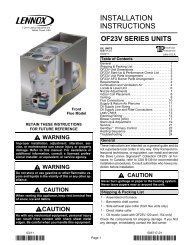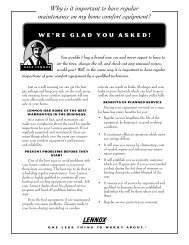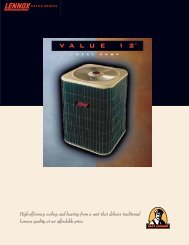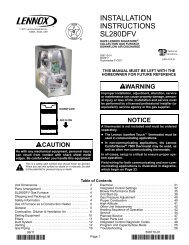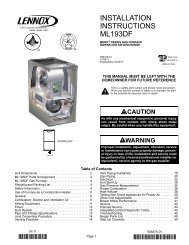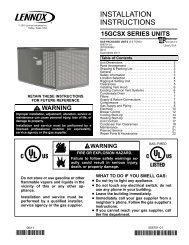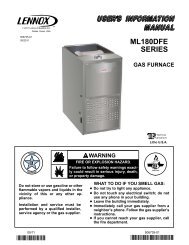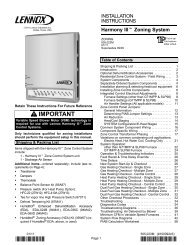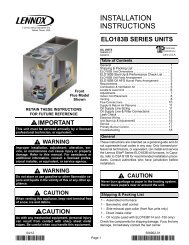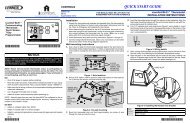INSTALLATION INSTRUCTIONS - Lennox
INSTALLATION INSTRUCTIONS - Lennox
INSTALLATION INSTRUCTIONS - Lennox
Create successful ePaper yourself
Turn your PDF publications into a flip-book with our unique Google optimized e-Paper software.
Joint Cementing Procedure<br />
All cementing of joints should be done according to the<br />
specifications outlined in ASTM D 2855.<br />
WARNING<br />
DANGER OF EXPLOSION!<br />
Fumes from PVC glue may ignite during system<br />
check. Allow fumes to dissipate for at least 5 minutes<br />
before placing unit into operation.<br />
1 − Measure and cut vent pipe to desired length.<br />
2 − Debur and chamfer end of pipe, removing any ridges<br />
or rough edges. If end is not chamfered, edge of pipe<br />
may remove cement from fitting socket and result in a<br />
leaking joint.<br />
3 − Clean and dry surfaces to be joined.<br />
4 − Test fit joint and mark depth of fitting on outside of pipe.<br />
5 − Uniformly apply a liberal coat of PVC primer for PVC or<br />
use a clean dry cloth for ABS to clean inside socket<br />
surface of fitting and male end of pipe to depth of fitting<br />
socket.<br />
NOTE − Furnace flue collar and air inlet fitting are both<br />
made of ABS material. Use transition solvent cement<br />
when joining ABS fittings to PVC pipe.<br />
6 − Promptly apply solvent cement to end of pipe and inside<br />
socket surface of fitting. Cement should be applied<br />
lightly but uniformly to inside of socket. Take<br />
care to keep excess cement out of socket. Apply second<br />
coat to end of pipe.<br />
NOTE − Time is critical at this stage. Do not allow primer<br />
to dry before applying cement.<br />
7 − Immediately after applying last coat of cement to pipe,<br />
and while both inside socket surface and end of pipe<br />
are wet with cement, forcefully insert end of pipe into<br />
socket until it bottoms out. Turn PVC pipe 1/4 turn during<br />
assembly (but not after pipe is fully inserted) to distribute<br />
cement evenly. DO NOT turn ABS or cellular<br />
core pipe.<br />
NOTE − Assembly should be completed within 20 seconds<br />
after last application of cement. Hammer blows<br />
should not be used when inserting pipe.<br />
8 − After assembly, wipe excess cement from pipe at end<br />
of fitting socket. A properly made joint will show a<br />
bead around its entire perimeter. Any gaps may indicate<br />
a defective assembly due to insufficient solvent.<br />
9 − Handle joints carefully until completely set.<br />
Venting Practices<br />
The thickness of construction through which vent pipes<br />
may be installed is 24" (610mm) maximum and 3/4"<br />
(19mm) minimum.<br />
1 − Use recommended piping materials for exhaust piping.<br />
2 − Secure all joints, including drip leg, gas-tight using approved<br />
cement.<br />
Suspend piping using hangers at a minimum of every 5<br />
feet (1.52m) for schedule<br />
40 PVC and every 3 feet<br />
STRAPPING<br />
(.91m) for ABS−DWV, PVC−<br />
(metal, plastic<br />
or large wire<br />
DWV, SPR−21 PVC, and<br />
ties)<br />
SDR−26 PVC piping. A suitable<br />
hanger can be fabricated<br />
by using metal or<br />
FIGURE 13<br />
plastic strapping or a large<br />
wire tie.<br />
3 − In areas where piping penetrates joists or interior<br />
walls, hole must be large enough to allow clearance on<br />
all sides of pipe through center of hole using a hanger.<br />
4 − Secure piping at the point where it exits the outside<br />
wall or roof in order to prevent transmission of vibration<br />
to the structure.<br />
5 − When furnace is installed in a residence where unit is<br />
shut down for an extended period of time, such as a<br />
vacation home, make provisions for draining condensate<br />
collection trap and lines.<br />
Exhaust Piping<br />
NOTE − A 2" diameter PVC street ell is located on the<br />
blower deck of 48C−110, 48C−110H and 60C−110 units<br />
(or use field replacement Canadian Kit). In upflow applications,<br />
the street ell must be glued using transition<br />
solvent cement directly into the unit flue collar (or use<br />
field replacement Canadian Kit). See figure 14. A 3" to 2"<br />
PVC reducing ell is located on the blower deck of the<br />
60D−135 units. In upflow applications, the reducing ell<br />
must be glued using transition solvent cement directly<br />
into the unit flue collar.<br />
1 − Choose the appropriate side for venting. Glue the<br />
field−provided exhaust vent pipe (or provided street<br />
ell) to the flue collar. All cement joints should be made<br />
according to the specifications outlined in ASTM D<br />
2855. Refer to pipe and fittings specifications and gluing<br />
procedures.<br />
IMPORTANT<br />
Exhaust piping and condensate trap must be<br />
installed on the same side of the unit in upflow and<br />
dowflow applications or use alternate drain kit<br />
76M20.<br />
Page 15



